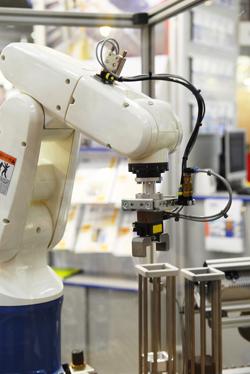529 Plan
January 27, 2014Estate Planning
January 27, 2014Robot Collaboration

Some argue that rather than replace human workers, robots will work in partnership with skilled laborers, alleviating the workload and complementing human skills.
Some argue that rather than replace human workers, robots will work in partnership with skilled laborers, alleviating the workload and complementing human skills. Bob DeAngelis of Precision Coatings in Boston, a small specialty manufacturer of precision devices, says that incorporating robotics to his manufacturing process required a significant capital investment, months of engineering time and meticulous production line planning.
DeAngelis had to retrain select operatives to support the robot equipment. Although engineering degrees were not needed by the team, critical thinking and problem solving were essential to support this new technology. DeAngelis reports that worker stress has been reduced and safety risks have declined because the robot can work around the clock when production schedules are tight. In the production process, worker knowledge of chemical components, mechanical operations, work flow and process efficiency are crucial when working directly with the robot. With the new robot and a highly trained support team, product defects are substantially less common and the company’s production yield has increased.
From Manufacturing to Creative Thinking
Innovation and automation have improved our standard of living. Automation reduces the cost of products, allowing people more disposable income. Innovations such as online shopping save us time and increase our efficiency. With time freed up from monotonous tasks that automation is now doing for us, we can think more creatively and come up with ever more innovations.)
There are no perfect solutions to solve the current unemployment rates and shortage of skilled workers, but many companies are working on it.
Business Owner Perspective
The first step in determining solutions for your current workforce is to establish which employees need new training, and what form it should take. Either an internal HR department or external career consultant can work directly with management to research and design effective training and educational programs. The goal is to fill talent gaps by discovering and fixing skill deficiencies.
Some companies find it helpful to create annual budgets for “talent improvement.” These employers implement skill and intellectual capability assessments for employees, then connect them with available training and educational programs.

